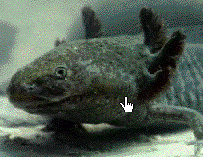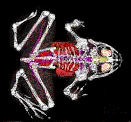





Amphibians: Why Study Them?


(Click on a picture to learn more...)
Amphibians are a convenient system for studying vertebrate development
for several reasons:
- They're vertebrates.
While that is obvious, historically amphibians were the only
vertebrate that could be easily studied using experimental techniques.
Not only are they vertebrates, but amphibians (except for caecilians,
an unusual order of amphibians) are tetropods, so they have all
of the fundamental features of land-dwelling vertebrates.
- They undergo external
development, so they can be observed and relatively easily
manipulated.
- They are physically large . Mature Xenopus oocytes are 1 mm in diameter,
which is an order of magnitude larger than a mouse oocyte, for
example. Ambystoma
oocytes are even larger.
- Their development is relatively rapid; they go from fertilization
through neurulation in approximately 18 hrs. at 22 deg. C.

Click on the skeleton to see a three-dimensional reconstruction
of a frog skeleton. (Size of movie, 1800K)


